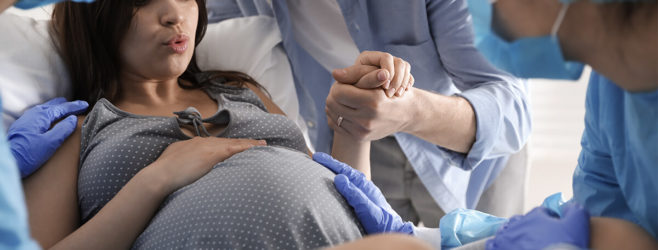Tailbone injury is a potential complication of giving birth. It is often caused by pressure from the baby’s head while passing through the birth canal, especially during the later stages of active labor.
The coccyx — or tailbone — is located at the base of the birth canal. The baby comes in direct contact with the coccyx when emerging from the birth canal. The pressure that builds when the baby passes through the birth canal can cause bruising, dislocation, or even fracture to the tailbone.
Generally, serious tailbone injuries can be avoided if proper steps are taken by the labor and delivery team. However, medical negligence on behalf of doctors and other health care providers can put the mother and child at risk of complications.
In severe cases, a broken tailbone during labor (fractured coccyx) can lead to chronic pain and significant mobility issues, making it difficult for new mothers to care for their newborns.
If medical malpractice played a role, you may have legal options to pursue the money your family needs to get back on track.
Call us at (800) 914-1562 right now or fill out this form to see if we can help.
How Common Is Tailbone Injury During Childbirth?
Breaking the tailbone during birth is rare, with bruising being more common and often the cause of postpartum tailbone pain.
“Many women experience tailbone pain after birth, due to ligament, muscle or posture changes, pressure from the baby, or trauma during childbirth, among other reasons.”
—PBS NewsHour
In general, women are 5 times more likely to experience tailbone pain than men, according to research published in the Ochsner Journal.
As a result, tailbone pain (coccydynia) is also very common during pregnancy, along with lower back pain. It is mainly experienced during the second and third trimesters.
Tailbone injury during childbirth is more likely to occur in long or difficult labor, especially when forceps or vacuum delivery are needed to remove the baby from the birth canal.
In a study of 57 women with tailbone pain after childbirth, 50.8% of cases were caused by forceps delivery complications.
These complications are also known to be some of the more common causes of birth injuries.
Causes of Tailbone Injury During Childbirth
Tailbone injury during birth occurs when the baby passes through the birth canal and comes in contact with the coccyx. If the mother’s tailbone is aligned correctly, it extends backward so the baby can pass through safely.
However, some women have tailbones that are stuck forward, which causes the baby to pass through with force. This pressure can even dislocate the tailbone, leading to muscle spasms and pain in the pelvic floor.
Several situations can lead to a tailbone injury during birth, including:
- Birth weight of more than 8 pounds and 13 ounces
- Difficult or complicated labor
- Face-up birth, which can push the baby’s skull against the tailbone
- Medical negligence
- Small or narrow pelvis
- Use of forceps or vacuum extractors
Additionally, if a woman has broken her tailbone in the past, she has a greater risk of another tailbone injury during birth. Inform your delivery team about any previous tailbone pain or injury before labor to minimize risk.
If you have unanswered questions or concerns about what could have caused your tailbone injury, talk to one of our nurses in confidence.
Symptoms of Tailbone Injury During Birth
Most women who experience tailbone injury during birth hear a crack or a popping sound during childbirth. If the tailbone is injured, there is usually tenderness and pain that feels worse when seated.
Additional symptoms of tailbone injury during birth include:
- Achy tailbone
- Anxiety or depression
- Back pain
- Difficulty during bowel movements
- Discomfort after sitting for a long time
- Pain during sex
- Piercing pain in the tailbone
- Poor sleep
If a tailbone injury during birth is suspected, your doctor will perform a visual exam of the area to check for any obvious fracture, deformity, mass, or infection. They will then conduct an internal and external rectal exam and may order X-rays to confirm the injury.
Treatment for Tailbone Pain After Birth
A bruised tailbone can usually heal itself in a few weeks. Fractures can take up to 8 weeks to heal, but tailbone pain after birth may last even longer if there is inflammation of the muscles or ligaments.
Fortunately, about 90% of patients who require treatment for a tailbone injury recover with at-home remedies.
Cleveland Clinic recommends these home remedies for a sore tailbone after birth:
- Applying hot or cold packs to your lower back
- Decreasing time spent seated
- Leaning forward while seated
- Non-steroidal anti-inflammatory drugs (NSAIDs), like ibuprofen, to reduce pain and swelling
- Stool softeners to decrease painful bowel movements
- Stretching and strengthening the pelvic and lower back muscles
- Taking a hot bath to relax your muscles
- Using a wedge-shaped gel cushion or donut-shaped pillow
- Wearing loose-fitting clothing
Chronic tension in pelvic muscles may cause pain. Long-lasting pain may be treated with physical therapy or steroid and local anesthetic injections.
In severe cases, surgery may be required for chronic pain. However, this option carries a far greater risk to the surrounding bones and muscles.
Doctor-recommended surgical options include partial coccygectomy (removal of part of the coccyx) and total coccygectomy (removal of the entire coccyx).
Finding Help After Tailbone Injury During Birth
Unfortunately, too many mothers face severe complications during childbirth. Women who have experienced tailbone injuries may be victims of medical negligence if the delivery team used excessive force during delivery.
Additionally, difficult deliveries can put babies at increased risk of serious birth injuries.
If you or your child were harmed, you do not have to navigate this situation alone. If you believe you suffered a preventable tailbone injury during birth that may have also injured your child, the Birth Injury Justice Center is here to help.
Call us at (800) 914-1562 right now to speak with one of our registered labor and delivery nurses.




